The AMD Ryzen 3 1300X and Ryzen 3 1200 CPU Review: Zen on a Budget
by Ian Cutress on July 27, 2017 9:30 AM EST- Posted in
- CPUs
- AMD
- Zen
- Ryzen
- Ryzen 3
- Ryzen 3 1300X
- Ryzen 3 1200
Benchmarking Performance: CPU Rendering Tests
Rendering tests are a long-time favorite of reviewers and benchmarkers, as the code used by rendering packages is usually highly optimized to squeeze every little bit of performance out. Sometimes rendering programs end up being heavily memory dependent as well - when you have that many threads flying about with a ton of data, having low latency memory can be key to everything. Here we take a few of the usual rendering packages under Windows 10, as well as a few new interesting benchmarks.
All of our benchmark results can also be found in our benchmark engine, Bench.
Corona 1.3: link
Corona is a standalone package designed to assist software like 3ds Max and Maya with photorealism via ray tracing. It's simple - shoot rays, get pixels. OK, it's more complicated than that, but the benchmark renders a fixed scene six times and offers results in terms of time and rays per second. The official benchmark tables list user submitted results in terms of time, however I feel rays per second is a better metric (in general, scores where higher is better seem to be easier to explain anyway). Corona likes to pile on the threads, so the results end up being very staggered based on thread count.
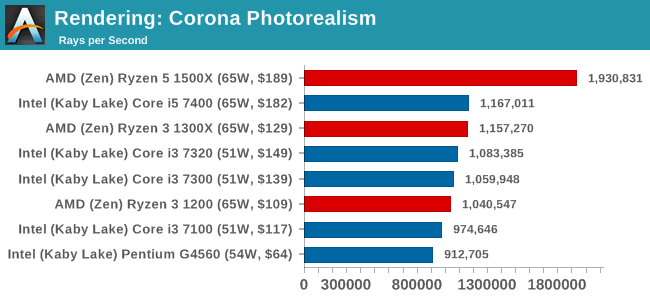
Blender 2.78: link
For a render that has been around for what seems like ages, Blender is still a highly popular tool. We managed to wrap up a standard workload into the February 5 nightly build of Blender and measure the time it takes to render the first frame of the scene. Being one of the bigger open source tools out there, it means both AMD and Intel work actively to help improve the codebase, for better or for worse on their own/each other's microarchitecture.
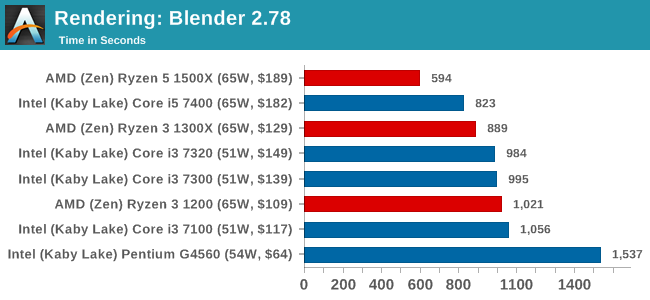
LuxMark v3.1: Link
As a synthetic, LuxMark might come across as somewhat arbitrary as a renderer, given that it's mainly used to test GPUs, but it does offer both an OpenCL and a standard C++ mode. In this instance, aside from seeing the comparison in each coding mode for cores and IPC, we also get to see the difference in performance moving from a C++ based code-stack to an OpenCL one with a CPU as the main host.
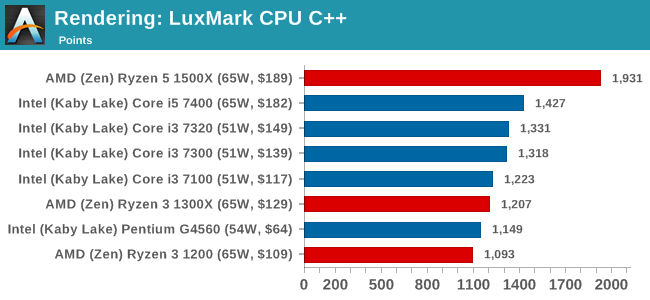

POV-Ray 3.7.1b4: link
Another regular benchmark in most suites, POV-Ray is another ray-tracer but has been around for many years. It just so happens that during the run up to AMD's Ryzen launch, the code base started to get active again with developers making changes to the code and pushing out updates. Our version and benchmarking started just before that was happening, but given time we will see where the POV-Ray code ends up and adjust in due course.
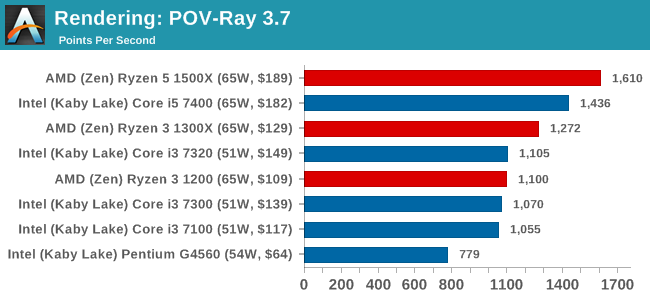
Cinebench R15: link
The latest version of CineBench has also become one of those 'used everywhere' benchmarks, particularly as an indicator of single thread performance. High IPC and high frequency gives performance in ST, whereas having good scaling and many cores is where the MT test wins out.
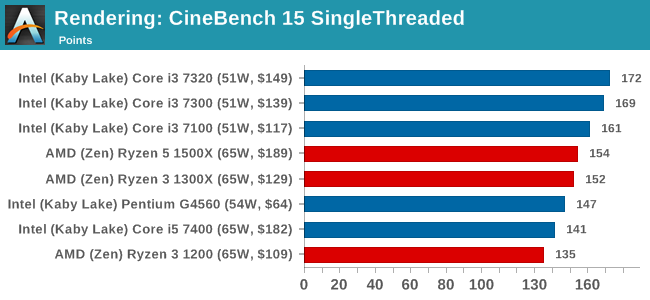
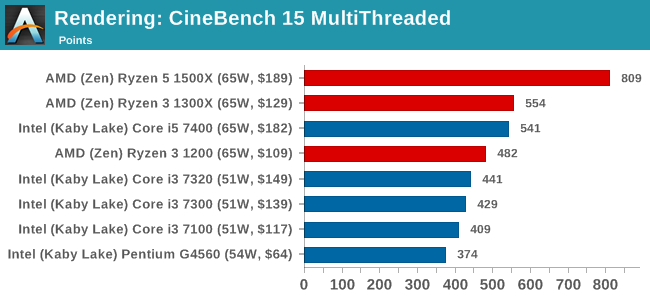










140 Comments
View All Comments
uibo - Thursday, July 27, 2017 - link
I thought you guys hated misleading scales on graphs.Looking at the performance per dollar graphs, I think the lowest point vertically should be -100%
lefenzy - Thursday, July 27, 2017 - link
That's silly. 0% is the zero on that graph, not some arbitrary -100%akrobet - Thursday, July 27, 2017 - link
Keep in mind that Intel is pulling the G4560 from the market, because it's "too good" for its price.MajGenRelativity - Thursday, July 27, 2017 - link
Source?MrCommunistGen - Thursday, July 27, 2017 - link
Not counting it as a "source" but I saw this pop up at wccftech. I didn't spend any time looking, but I haven't stumbled upon any corroboration on other sites in my tech reading.MajGenRelativity - Thursday, July 27, 2017 - link
I just found the article on wccftech. It actually said that Intel is NOT killing off the G4560T1beriu - Thursday, July 27, 2017 - link
wccftech....
....
BWHAHAHAHAHAHAH
GreenMeters - Thursday, July 27, 2017 - link
SHED does not exist. Ryzen 7 maps to the standard i7 market that has never been called HEDT. Threadripper is HEDT. The fact that it puts Intel's HEDT to shame doesn't mean it's a new segment. It means Intel better get with the program.Ian Cutress - Thursday, July 27, 2017 - link
Ryzen 7 was mapped against Intel's Broadwell-E HEDT platform at launch for core count, performance, and aggressive pricing. Threadripper is a stage above that, and isn't even called HEDT internally at AMD. Then we have the HCC core count silicon coming from Intel. SHED exists.DrKlahn - Thursday, July 27, 2017 - link
Ok I'm seriously beginning to wonder about the objectivity here. So your conclude this:"First is that the Ryzen 3 1200 does not look like an attractive option. It performs +2-3% of the Pentium but is $30 more expensive, and the Core i3-7100 beats it by 8% for only a sub-$10 cost."
But aren't mentioning that the Pentiums are locked parts and the 1200 isn't? Your competing sites do have overclocking data and the Pentiums are hopelessly outclassed. Granted not everyone overclocks, but on an enthusiast site that at least warrants a mention. Not everyone will read your followup(s) and that conclusion does not tell the full story. I know if I was building a machine a 1200 4 core that overclocks to 3.8-4GHz is well worth the $30.